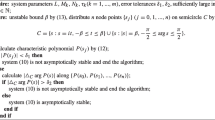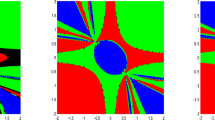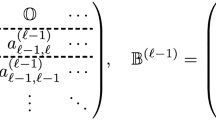Abstract
We consider the application of implicit Runge–Kutta (IRK) methods to systems of implicit ordinary differential equations (ODEs). We are especially interested in the situation when stiffness arises. We show that the eigenvalues of major families of A-stable implicit Runge–Kutta methods are simple and have non-negative real part. We give necessary and sufficient conditions for the invertibility of approximate Jacobians of IRK methods. The main result of this note provides some sufficient conditions to ensure local contractivity, hence convergence, of modified Newton iterations of IRK methods for stiff ODEs with step size conditions independent of stiffness.
Similar content being viewed by others
References
Söderlind, G., Jay, L.O., Calvo, M.: Stiffness 1952–2012: Sixty years in search of a definition. BIT Numer. 55, 531–558 (2015)
Hairer, E., Wanner, G.: Solving ordinary differential equations II. Stiff and differential-algebraic problems, Comput. Math., vol. 14. Springer, Berlin, Second Revised Edition (1996)
Alexander, R.: The modified Newton method in the solution of stiff ordinary differential equations. Math. Comput. 57, 673–701 (1994)
Calvo, M., González-Pinto, S., Montijano, J.I.: On the iterative solution of the algebraic equations in fully implicit Runge-Kutta methods. Numer. Algorithms 23, 97–113 (2000)
van Dorsselear, J.L.M., Spijker, M.N.: The error committed by stopping the Newton iteration in the numerical solution of stiff initial value problem. IMA J. Numer. Anal. 14, 183–209 (1994)
Mardal, K.A., Nilssen, T.K., Staff, G.A.: Order-optimal preconditioners for implicit Runge-Kutta schemes applied to parabolic PDEs. SIAM J. Sci. Comput. 29, 361–375 (2007)
Acknowledgements
We gracefully thank the anonymous reviewer for their stimulating remarks to improve the readability of the paper. We also thank Ben Southworth for pointing out the reference [6] to us.
Author information
Authors and Affiliations
Corresponding author
Ethics declarations
Conflict of interest
The authors have no financial or proprietary interests in any material discussed in this article.
Additional information
Publisher's Note
Springer Nature remains neutral with regard to jurisdictional claims in published maps and institutional affiliations.
A Appendix
A Appendix
In this appendix we show that the two concepts of irreducibility for an IRK method and irreducibility of the corresponding rational stability function are unrelated, thus disproving the statement made in [6, p.368] that “Irreducibility gives that the fraction cannot be reduced”.
The stability function of s-stage IRK methods is given by \(R(z)=P(z)/Q(z)\) where \(P(z)=\det (I_s-z(A-{ 1 \hspace{-2.89993pt}\textrm{l}_s}b^T))\), \( 1 \hspace{-2.89993pt}\textrm{l}_s:=(1,\ldots ,1)\in {\mathbb {R}}^s\), and \(Q(z)=\det (I_s-zA)\). For example consider diagonally implicit Runge–Kutta (DIRK) methods with \(s=2\) stages. Their IRK matrix A is lower triangular
For any 2-stage IRK method to be consistent we must have \(b_2=1-b_1\). We assume \(b_1\not \in \{0,1\}\) otherwise the DIRK method would be reducible. We have
Hence assuming \(a_{11}\not =0\) and \(a_{22}\not =0\) the roots of Q(z) are simply \(z_1=1/a_{11}\) and \(z_2=1/a_{22}\). We will choose the coefficients of the DIRK method such that we also have \(P(z_1)=0\) which will thus imply that the stability function R(z) is reducible, henceforth providing our sought counterexample. We have
One can even require the DIRK method to be of order 2 though it is not necessary for our purpose here. For order 2 we must have the additional condition
This condition implies that \(P(z_1)=0\) is now simply equivalent to having \(a_{22}=1/2\). Hence, we are left with the condition
Solving for example for \(a_{21}\) we obtain
We have found solutions with two (almost) free parameters \(b_1\not \in \{0,1\}\) and \(a_{11}\not \in \{0,1/2\}\). Choosing for example \(a_{11}=1/3\) and \(b_1=3/4\) leads to the following irreducible DIRK method with Radau II nodes and weights
with reducible stability function \(R(z)=P(z)/Q(z)\) where
which is even A-stable (!) since \(R(z)=(1+z/2)/(1-z/2)\) is the (1, 1)-Padé approximation to \(e^z\). Notice here that the IRK matrix A here is nonsingular, its eigenvalues are both strictly positive (1/3 and 1/2), although the DIRK method does not satisfy the conditions of Theorem 2.1. In fact from
we find that \(\alpha =-1/2\) and thus
for any choice of \(a_{11}\) and \(b_1\). This also follows from (A.1) by calculation. The corresponding DIRK methods are all A-stable since \(R(z)=(1+z/2)/(1-z/2)\) is the (1, 1)-Padé approximation to \(e^z\) even when choosing a negative value for \(a_{11}\). For example choosing now instead the absurd value \(a_{11}=-1/2\) and \(b_1=1/3\) leads to the following irreducible DIRK method
with reducible stability function \(R(z)=P(z)/Q(z)\) where
Notice that the IRK matrix A here is nonsingular, one of its eigenvalues is strictly negative (\(-1/2\)) and the other one is strictly positive (1/2). Of course this DIRK method also does not satisfy the conditions of Theorem 2.1.
As a final note consider the 2-stage Lobatto IIIB method
which is based on the trapezoidal rule quadrature formula. It is a reducible method when applied to autonomous ODEs \(dx/dt=f(x)\) and it is equivalent to the implicit midpoint rule, but its stability function is irreducible.
Rights and permissions
Springer Nature or its licensor (e.g. a society or other partner) holds exclusive rights to this article under a publishing agreement with the author(s) or other rightsholder(s); author self-archiving of the accepted manuscript version of this article is solely governed by the terms of such publishing agreement and applicable law.
About this article
Cite this article
Jay, L.O., Sokratova, O. A note on approximate Jacobians of implicit Runge–Kutta methods and convergence of modified Newton iterations. Bit Numer Math 63, 54 (2023). https://doi.org/10.1007/s10543-023-00994-8
Received:
Accepted:
Published:
DOI: https://doi.org/10.1007/s10543-023-00994-8
Keywords
- Approximate Jacobian
- Contraction mapping
- Fixed point iterations
- Implicit Runge–Kutta methods
- Modified Newton method
- Negative semi-definiteness
- Ordinary differential equations
- Stiffness




